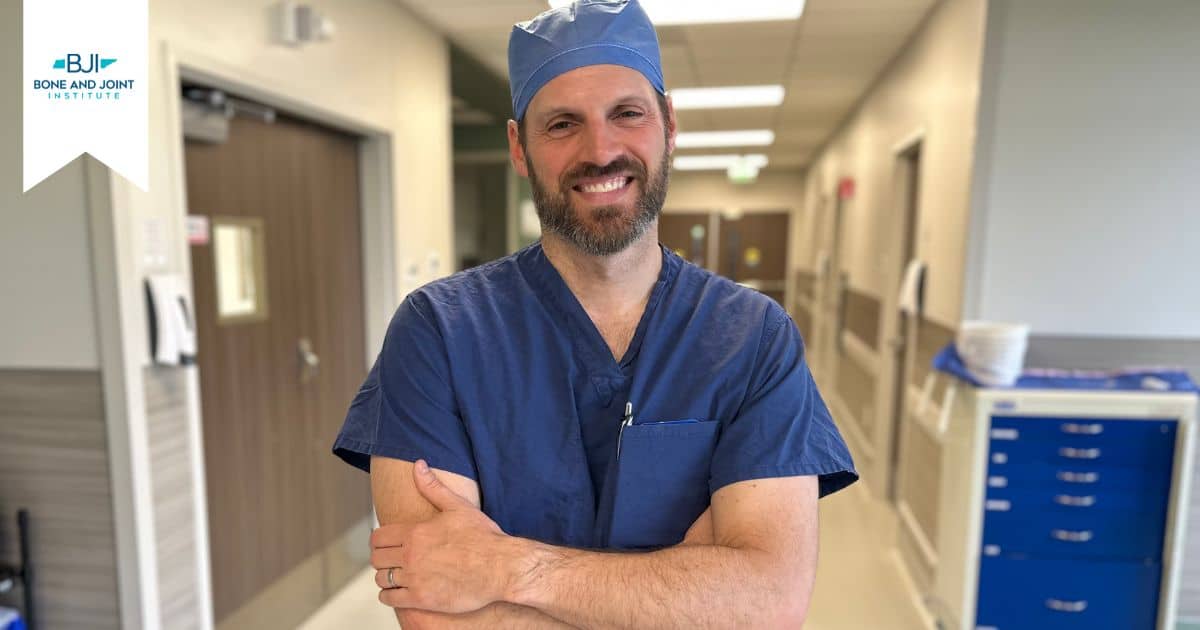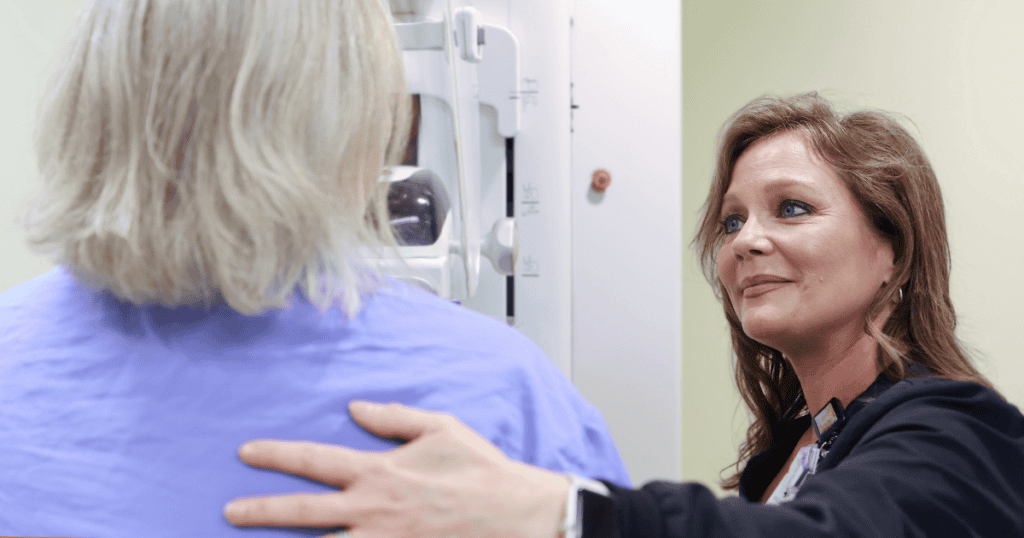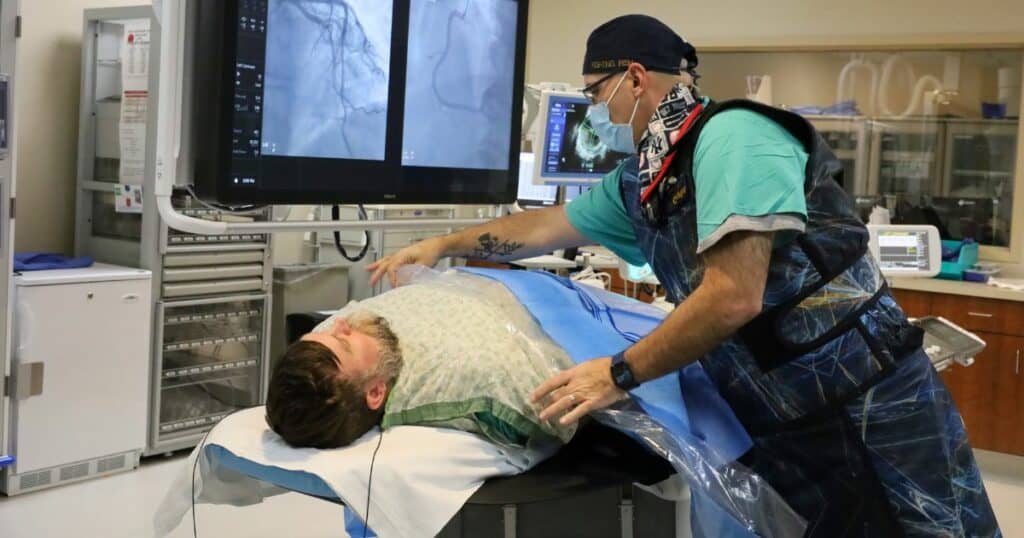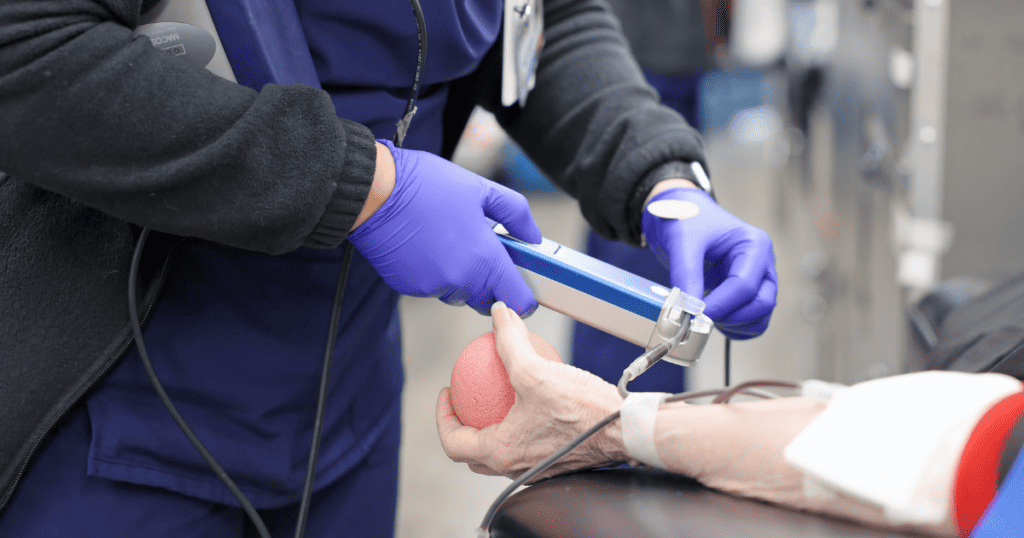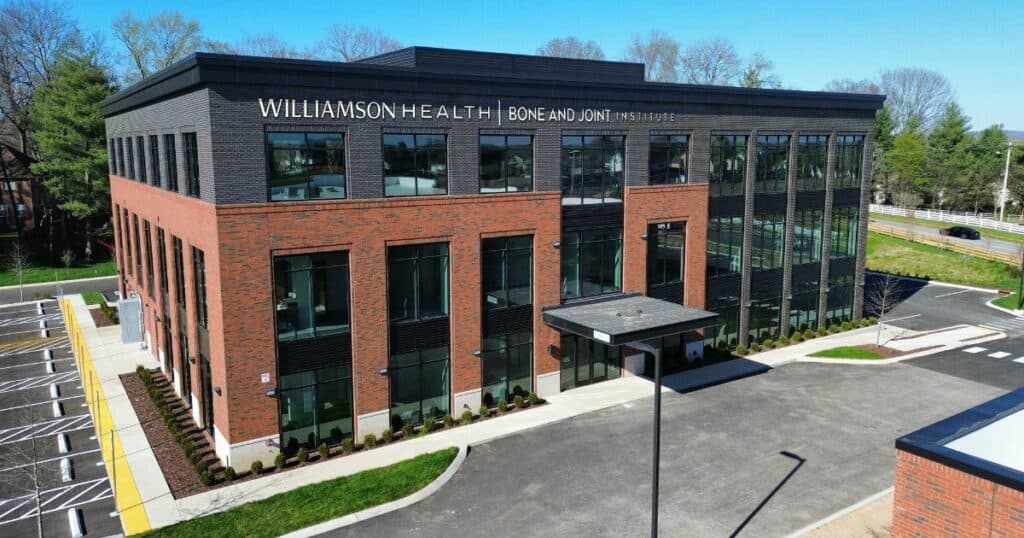A Better Approach to Anterior Hip Replacement with Dr. Brian Perkinson
Published: July 15, 2024
Originally published in the Williamson Source —
Hip replacements are one of the most common orthopaedic surgical procedures performed in the United States every year. Our joints undergo a lot of wear and tear on a daily basis, and, combined with genetic predisposition, that wear results in damage that becomes uncomfortable to manage over time. Many advancements have been made in surgical approaches to joint replacements. One such advancement in hip replacement includes a better directional approach and the inclusion of robotic-assisted technologies.
Orthopaedic surgeon Brian Perkinson, M.D., of Bone and Joint Institute of Tennessee, specializes in hip and knee replacement and preservation as well as general orthopaedics and fracture care. He explains the anterior hip replacement surgical procedure and improved patient recovery process.
What is Anterior Hip Replacement?
Anterior hip replacement describes a specific directional approach (where to access the hip), to surgically replace the hip joint. Traditional hip replacements have been done through the side (lateral hip replacement) or the back (posterior hip replacement). Anterior hip replacement means the surgical procedure is approached through the front of the body.
What are the benefits of an anterior approach?
Dr. Perkinson explains, “There is a lot of value to the anterior replacement approach, but it comes down to anatomy. In this approach, we’re taking advantage of a natural intramuscular and internervous plane through the front of the hip. This means that we are spreading the muscles, not cutting or splitting muscles.” An anterior hip replacement allows for more minimally invasive surgery, resulting in shorter incisions and less tissue damage.
“Studies have shown that an anterior hip replacement compared to a posterior replacement has less muscle damage as measured by muscle damage markers in the bloodstream.” Dr. Perkinson further explains, “This less invasive approach translates to a shorter length of stay in a healthcare facility and faster recovery in the first 6 to 12 weeks.” A patient having this surgery should expect faster functional walking without the use of any assistance devices like crutches or walkers and less pain than a posterior or lateral approach.
What are other advantages of anterior hip replacement compared to other approaches?
Dr. Perkinson describes more advantages to the anterior hip replacement: “One of the worst complications from a hip replacement is called a dislocation, where the ball of the femur can come out of the hip socket after surgery. In traditional approaches, those rates vary anywhere from 2 to 4% of dislocation. Anterior hip replacements have much less than 1% out chance of the ball coming out of the socket, so the risk of dislocation is almost negligible.” Essentially, the less invasive anterior approach spares all the important muscles holding the ball in the socket, making the hip joint more stable after surgery.
It’s important to note that, like any major surgery, anterior hip replacement does have the risk of some complications. This surgery carries a slightly higher risk of fracture at the time of surgery, as well as the potential for nerve damage that can lead to numbness in the thigh. However, Dr. Perkinson reassures patients that “higher levels of proficiency allow a surgeon to avoid these complications easily. The minimal risk of these complications with anterior hip replacement is heavily outweighed by the benefits of recovery and lessened risk of dislocation.”
Who is a candidate for anterior hip replacement surgery?
Virtually everyone needing a hip replacement is a candidate for this method. As Dr. Perkinson says, “Everyone is a candidate with a skilled surgeon. Anterior hip replacement has a steep learning curve, so surgeon experience matters. Studies show that it takes more than 50 anterior hip replacement procedures before a surgeon achieves competency, compared to 5-10 surgeries for most procedures.” With more than 3,500 anterior hip replacements performed by him over the last ten years, Dr. Perkinson’s preferred hip replacement method for his patients is anterior hip replacement for the best result and recovery.
The typical patient demographics are people in their 50s and above who struggle with osteoarthritis. Because of genetic predisposition, joint wear-and-tear, or previous history of injury, arthritis can develop later in life. Occasionally, a patient might require a hip replacement because of a serious fracture or a condition called osteonecrosis of the femoral head (a severe condition in which the femoral head begins to die and deteriorate), but he states “90% of my patients have arthritis.”
What technological advancements have contributed to the success of anterior hip replacement?
While it’s essential that a highly skilled surgeon perform this more advanced procedure, advancements in technology have contributed to even higher rates of success in anterior hip replacement. Companies have developed specific instruments, equipment, and robotics for surgeons to operate with the highest level of proficiency in their surgeries.
Dr. Perkinson takes advantage of these technologies in his operating rooms: “I use a specialized operating table that allows me to position the patient in surgery and control their leg comfortably. I also use a digital guidance system to improve the accuracy of the implant positioning, as well as the creation of hip biomechanics.” Hip biomechanics refers to positioning the hip socket correctly so that all the muscles function appropriately. He says, “the patient feels hip biomechanics function correctly with balanced leg length and good strength around their hip” as they recover after surgery.
What is the recovery time for a patient with this hip replacement method?
The typical patient receives this surgery as an outpatient procedure, meaning they go home the same day of surgery. At Bone and Joint Institute, Dr. Perkinson’s patients are walking within an hour of surgery and go home with exercises to perform. Most patients do not require formal physical therapy, though that can be coordinated through Bone and Joint Institute if required.
The most notable component of recovery with anterior hip replacement is the lack of restrictions on leg positioning. Dr. Perkinson says “there are no rules by which a patient has to position their leg to avoid the hip coming out of the socket after this surgery. They’re allowed to walk, sit, stand, and lie down without restrictions for the first three months. Restrictions are very common with other approaches.”
Are there any preparations a patient should make to ensure a successful surgery?
While Dr. Perkinson does not prescribe particular pre-habilitation activities before surgery, he does recommend focusing on your general health and wellness in the weeks leading up to it.
“From the patient standpoint, they should optimize their wellness to the best of their ability. Avoidance of smoking, limiting alcohol, improving nutrition with high-quality protein and good caloric intake, and hydration up to the day of surgery” can all contribute to a body in healthy condition to undergo surgery. Light exercise can also be beneficial, but since hip pain with arthritis can limit mobility, it’s not required.
More about Dr. Brian Perkinson at Bone and Joint Institute of Tennessee
Brian Perkinson, M.D., describes himself as a hometown kid who grew up in Franklin, Tennessee. He went through the Franklin public school system and graduated from Battle Ground Academy in 1996. Dr. Perkinson has the pleasure of returning to his hometown as an orthopaedic surgeon at Bone and Joint Institute to operate on friends, family, and the community he grew up in and loves. He and his wife have three children and enjoy traveling and learning about other cultures.
Dr. Perkinson is a board-certified orthopaedic surgeon at Bone and Joint Institute of Tennessee specializing in anterior hip replacement, partial knee replacement, robotic joint replacement, total knee replacement, revision hip, and knee replacement, and reconstruction of the hip and knee. He received his undergraduate degree in biomedical engineering from the University of Tennessee, Knoxville, and his medical degree from the University of Tennessee Health Science Center. Dr. Perkinson completed his residency at Campbell Clinic Orthopaedics in Memphis and his fellowship training in adult reconstruction and total and partial joint replacement at the Anderson Orthopaedic Clinic in Alexandria, Virginia.
To learn more about personalized surgical treatment for osteoarthritis and anterior hip replacement surgery, contact Bone and Joint Institute of Tennessee. Call 615-791-2630 or schedule an appointment online.
A Better Approach to Anterior Hip Replacement with Dr. Brian Perkinson
Originally published in the Williamson Source —
Hip replacements are one of the most common orthopaedic surgical procedures performed in the United States every year. Our joints undergo a lot of wear and tear on a daily basis, and, combined with genetic predisposition, that wear results in damage that becomes uncomfortable to manage over time. Many advancements have been made in surgical approaches to joint replacements. One such advancement in hip replacement includes a better directional approach and the inclusion of robotic-assisted technologies.
Orthopaedic surgeon Brian Perkinson, M.D., of Bone and Joint Institute of Tennessee, specializes in hip and knee replacement and preservation as well as general orthopaedics and fracture care. He explains the anterior hip replacement surgical procedure and improved patient recovery process.
What is Anterior Hip Replacement?
Anterior hip replacement describes a specific directional approach (where to access the hip), to surgically replace the hip joint. Traditional hip replacements have been done through the side (lateral hip replacement) or the back (posterior hip replacement). Anterior hip replacement means the surgical procedure is approached through the front of the body.
What are the benefits of an anterior approach?
Dr. Perkinson explains, “There is a lot of value to the anterior replacement approach, but it comes down to anatomy. In this approach, we’re taking advantage of a natural intramuscular and internervous plane through the front of the hip. This means that we are spreading the muscles, not cutting or splitting muscles.” An anterior hip replacement allows for more minimally invasive surgery, resulting in shorter incisions and less tissue damage.
“Studies have shown that an anterior hip replacement compared to a posterior replacement has less muscle damage as measured by muscle damage markers in the bloodstream.” Dr. Perkinson further explains, “This less invasive approach translates to a shorter length of stay in a healthcare facility and faster recovery in the first 6 to 12 weeks.” A patient having this surgery should expect faster functional walking without the use of any assistance devices like crutches or walkers and less pain than a posterior or lateral approach.
What are other advantages of anterior hip replacement compared to other approaches?
Dr. Perkinson describes more advantages to the anterior hip replacement: “One of the worst complications from a hip replacement is called a dislocation, where the ball of the femur can come out of the hip socket after surgery. In traditional approaches, those rates vary anywhere from 2 to 4% of dislocation. Anterior hip replacements have much less than 1% out chance of the ball coming out of the socket, so the risk of dislocation is almost negligible.” Essentially, the less invasive anterior approach spares all the important muscles holding the ball in the socket, making the hip joint more stable after surgery.
It’s important to note that, like any major surgery, anterior hip replacement does have the risk of some complications. This surgery carries a slightly higher risk of fracture at the time of surgery, as well as the potential for nerve damage that can lead to numbness in the thigh. However, Dr. Perkinson reassures patients that “higher levels of proficiency allow a surgeon to avoid these complications easily. The minimal risk of these complications with anterior hip replacement is heavily outweighed by the benefits of recovery and lessened risk of dislocation.”
Who is a candidate for anterior hip replacement surgery?
Virtually everyone needing a hip replacement is a candidate for this method. As Dr. Perkinson says, “Everyone is a candidate with a skilled surgeon. Anterior hip replacement has a steep learning curve, so surgeon experience matters. Studies show that it takes more than 50 anterior hip replacement procedures before a surgeon achieves competency, compared to 5-10 surgeries for most procedures.” With more than 3,500 anterior hip replacements performed by him over the last ten years, Dr. Perkinson’s preferred hip replacement method for his patients is anterior hip replacement for the best result and recovery.
The typical patient demographics are people in their 50s and above who struggle with osteoarthritis. Because of genetic predisposition, joint wear-and-tear, or previous history of injury, arthritis can develop later in life. Occasionally, a patient might require a hip replacement because of a serious fracture or a condition called osteonecrosis of the femoral head (a severe condition in which the femoral head begins to die and deteriorate), but he states “90% of my patients have arthritis.”
What technological advancements have contributed to the success of anterior hip replacement?
While it’s essential that a highly skilled surgeon perform this more advanced procedure, advancements in technology have contributed to even higher rates of success in anterior hip replacement. Companies have developed specific instruments, equipment, and robotics for surgeons to operate with the highest level of proficiency in their surgeries.
Dr. Perkinson takes advantage of these technologies in his operating rooms: “I use a specialized operating table that allows me to position the patient in surgery and control their leg comfortably. I also use a digital guidance system to improve the accuracy of the implant positioning, as well as the creation of hip biomechanics.” Hip biomechanics refers to positioning the hip socket correctly so that all the muscles function appropriately. He says, “the patient feels hip biomechanics function correctly with balanced leg length and good strength around their hip” as they recover after surgery.
What is the recovery time for a patient with this hip replacement method?
The typical patient receives this surgery as an outpatient procedure, meaning they go home the same day of surgery. At Bone and Joint Institute, Dr. Perkinson’s patients are walking within an hour of surgery and go home with exercises to perform. Most patients do not require formal physical therapy, though that can be coordinated through Bone and Joint Institute if required.
The most notable component of recovery with anterior hip replacement is the lack of restrictions on leg positioning. Dr. Perkinson says “there are no rules by which a patient has to position their leg to avoid the hip coming out of the socket after this surgery. They’re allowed to walk, sit, stand, and lie down without restrictions for the first three months. Restrictions are very common with other approaches.”
Are there any preparations a patient should make to ensure a successful surgery?
While Dr. Perkinson does not prescribe particular pre-habilitation activities before surgery, he does recommend focusing on your general health and wellness in the weeks leading up to it.
“From the patient standpoint, they should optimize their wellness to the best of their ability. Avoidance of smoking, limiting alcohol, improving nutrition with high-quality protein and good caloric intake, and hydration up to the day of surgery” can all contribute to a body in healthy condition to undergo surgery. Light exercise can also be beneficial, but since hip pain with arthritis can limit mobility, it’s not required.
More about Dr. Brian Perkinson at Bone and Joint Institute of Tennessee
Brian Perkinson, M.D., describes himself as a hometown kid who grew up in Franklin, Tennessee. He went through the Franklin public school system and graduated from Battle Ground Academy in 1996. Dr. Perkinson has the pleasure of returning to his hometown as an orthopaedic surgeon at Bone and Joint Institute to operate on friends, family, and the community he grew up in and loves. He and his wife have three children and enjoy traveling and learning about other cultures.
Dr. Perkinson is a board-certified orthopaedic surgeon at Bone and Joint Institute of Tennessee specializing in anterior hip replacement, partial knee replacement, robotic joint replacement, total knee replacement, revision hip, and knee replacement, and reconstruction of the hip and knee. He received his undergraduate degree in biomedical engineering from the University of Tennessee, Knoxville, and his medical degree from the University of Tennessee Health Science Center. Dr. Perkinson completed his residency at Campbell Clinic Orthopaedics in Memphis and his fellowship training in adult reconstruction and total and partial joint replacement at the Anderson Orthopaedic Clinic in Alexandria, Virginia.
To learn more about personalized surgical treatment for osteoarthritis and anterior hip replacement surgery, contact Bone and Joint Institute of Tennessee. Call 615-791-2630 or schedule an appointment online.
Published: July 15, 2024
